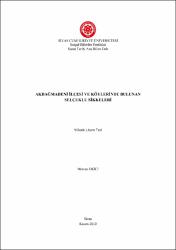| dc.contributor.advisor | Eser, Erdal | |
| dc.contributor.author | Ekici, Mercan | |
| dc.date.accessioned | 2022-04-28T09:23:17Z | |
| dc.date.available | 2022-04-28T09:23:17Z | |
| dc.date.issued | 2019 | tr |
| dc.date.submitted | 2019-10-04 | |
| dc.identifier.other | xiii, 121 | |
| dc.identifier.uri | https://hdl.handle.net/20.500.12418/12593 | |
| dc.description.abstract | Sikke, uygarlık tarihi boyunca önemli buluşlardan biri olmuş ve ticaret
hayatının vazgeçilmez bir parçası olarak kullanılmıştır. Ülkelerin uluslar arası
ilişkilerinde para politikası her devirde önemli bir yere sahip olmuştur. Sikkeler
üzerlerinde barındırdıkları yazı, motif ve figürler nedeni ile tarih, sanat ve kültürel
etkileşim kaynağı olarak kesin bilgiler aktarmasından dolayı belge niteliğinde
özelliğe sahip olmuştur. Ayrıca devlet ekonominsin temel birimi olma özelliğine
sahip olan sikkeler siyasal ve sosyal dengenin korunmasına da yardımcı olmuştur.
Devletin refah seviyesinin artışına paralel olarak iç barış sağlanmış ve sultanların
bütçe zenginliği ile halka karşı gücünün artmasında da büyük rol oynamıştır.
Anadolu Selçuklu Devleti’nin ilk sikke basımı I. Mesud (1116-1155) ile
başlamış ve ilk gümüş sikke basımı ise II. Kılıç Arslan (1156-1192) ile devam
etmiştir. I. Alaaddin Keykubad (1220-1236) ise sikke üzerinde ilk kez Selçuki sülüsü
kullanan sultan olmuş ve devamında II. İzzeddin Keykavus (1246-1248), IV. Kılıç
Arslan (1259-1265) ve II. Alaaddin Keykubad (1249-1257) aynı şekilde Selçuki
sülüsü geleneğini devam ettirmiştir. Ayrıca bu sultanlar 3 Kardeşler olarak tahta
çıkmış müşterek bir hükümdarlık sürmüşlerdir. II. Gıyaseddin Keyhüsrev (1237-
1246) ise klasik Selçuklu sikke anlayışının dışına çıkmış ve sikkelerinde Şir-i Hurşit
kompozisyonu kullanmıştır. Bu dönemin klasik sikke şekli, sikkenin dış ve iç kısmını
kaplayan düz ve inci dizili daire evi olmuştur. Bu şekli tamamlayan süslemeler ise
bitkisel rumî motifi ve yıldız motifleri olmuştur. Sikke üzerinde bulunan süslemeleri
her sultan kendi arzu, isteğine göre kullanmış ve gücünü en iyi şekilde yansıtacak
olan sikkeler üzerinde lakaplarına ve ünvanlarına yer vermişlerdir.
Bu çalışmanın amacı, Yozgat Müzesi koleksiyonuna 28.07.2015 tarihinde
eklenen Anadolu Selçuklu dönemine ait 1005 sikkeyi incelemek ve daha önce
incelenmiş olan Anadolu Selçuklu sikkeleri ile benzerlik ve farklılıkları açık bir
şekilde tanımlayıp değerlendirmektir. | tr |
| dc.description.abstract | The coin was one of the important invences through out the history of
civilization and was used as an indispensable part of the trade life. Monetarypolicy
has had an importantplace in the international relations of countries in everyera.
Because of the inscriptions, motif sandfigures they have on them, the coins have the
character of documents dueto the irpreciseinformation as a source of history, art and
cultural interaction. Inaddition, coins, which are the basicunit of the stateeconomy,
helpedtomaintain the political and social balance. Inparallel with the increase in the
welfarelevel of the state, internalpeace was achievedand the sultans' budgetweal
thand power against the peopleplayed a major role in increasing.
The first coin printing of the Anatolian Seljuk State started with Mesud I
(1116-1155) and the first silver coin printing continued with Kılıç Arslan II. (1156-
1192). Alaaddin Keykubad I. (1220-1236) was the Sultan who first used the Seljuks
thuluth on the coin and continuedto İzzeddin Keykavus II. (1246-1248), Kılıç Arslan
IV. (1259-1265) and Alaaddin Keykybad II. (1249-1257) in the sameway, he
continued the tradition of Seljuks thuluth. Inaddition, the sesultansascendedto the
throne as the 3 Brothers and maintained a jointreign. Gıyaseddin Keyhüsrev II.
(1237-1246) went beyond the classical Seljuk coin and used the composition of shiro
khorshid in his coins. Theclassiccoinshape of thisperiod has been a
flatandpearlcircle house covering the out erandinner parts of the coin. The or
naments that complement this shape have been the herbal Rumi motif and the
starmotifs. Each sultan used the decorations on the coins accordingto his
owndesireand willand gave the irnicknames and titles on the coins which would best
reflect his power.
The main goal of study is examine the collection of 1005 coins belonging to
the Anatolian Seljuk period added on 28.07.2015 the Yozgat Museum collection and
saliently identify and describe the similarities and differences witht hepreviously
examined Anatolian Seljuk coins. | tr |
| dc.language.iso | tur | tr |
| dc.publisher | Sivas Cumhuriyet Üniversitesi-Sosyal Bilimler Enstitüsü | tr |
| dc.rights | info:eu-repo/semantics/openAccess | tr |
| dc.subject | Anadolu Selçuklu | tr |
| dc.subject | Darphane | tr |
| dc.subject | Sikke | tr |
| dc.subject | Yazı | tr |
| dc.title | Akdağmadeni İlçesi Ve Köylerindebulunan Selçuklu Sikkeleri | tr |
| dc.type | masterThesis | tr |
| dc.contributor.department | Sosyal Bilimler Enstitüsü | tr |
| dc.relation.publicationcategory | Tez | tr |















